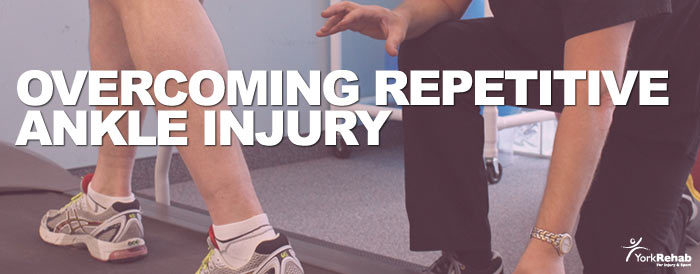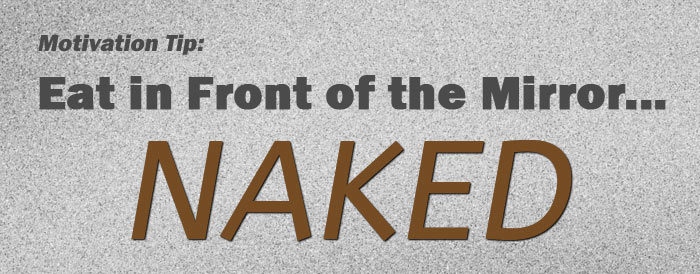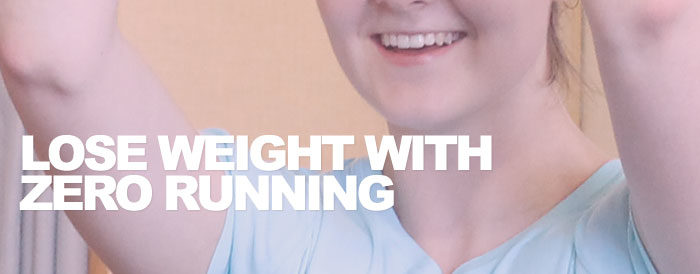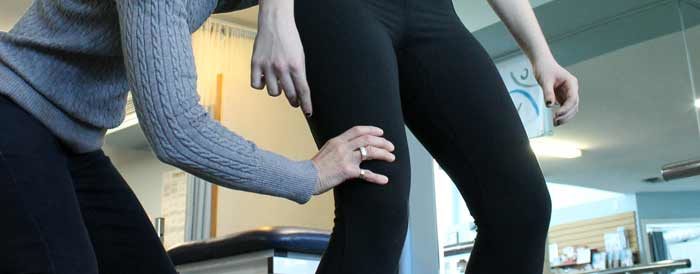running
Overcoming Repetitive Ankle Injuries
A common injury for people involved in sports such as soccer, tennis, squash, or running is an ankle sprain. Many athletes and weekend warriors alike have experienced this injury, often multiple times, and may rely on using a brace for support to prevent re-injury or be forced to cut back on their participation due to recurring injury. It is possible to minimize the recurrence rate of this injury by seeing a qualified physiotherapist who can assess for and address the following limitations that are common in people with repetitive ankle injuries.
Some people who have had a long history of ankle injury have range of motion limitations. What can happen is the ankle swells following the sprain, and it gradually recovers, but the scar tissue that forms to rebuild the injured tissue does not get adequately stretched. This is how a stiff ankle can develop, and playing sports with this movement loss can lead to another injury quickly. A physiotherapist can identify these limitations and prescribe the proper stretches to recover as much mobility as possible.
Secondly, following the recovery from an acute (within 6 weeks of injury) ankle sprain there might not be any residual pain, but often there is a lingering weakness. Because the ankle feels free of pain the athlete is compelled to return to their sport, neglecting the strength deficits that are present. Depending on the sport, this might manifest as decreased endurance, overall strength, or explosive power such as in jumping sports. This can be remedied by regularly performing the appropriate exercises specific to your sport, exercises which can be determined by a physiotherapist.
A hidden impairment that an athlete may not notice after an ankle injury is decreased proprioception. This refers to the “position sense” of your joints and ligaments, similar in a way to other senses such as vision and smell. There are sensors embedded in these tissues that give the body feedback about where it is in physical space, and we rely on this sense to maintain good balance and stability during weight-bearing activity. After an ankle sprain, we often lose some of this sense, but it can be readily retrained much like muscle strength can. Specific balance exercises can be done to regain this sense, with progressions to sport-specific activity.
Building on that last point, before returning to your activity is considered, an athlete should be able to perform the necessary tasks involved in the activity. For example, a soccer player should be able to sprint, change directions quickly, kick, and dribble a ball. Often the speed at which these activities can be done following an ankle injury is much less than in normal conditions. Agility exercises and plyometrics, which are a type of exercise involving explosive movements such as jumps and sprints, are essential here. Regaining these skills is crucial to minimize the risk of long-term ankle injury recurrences.
To summarize, if you have had trouble with repetitive ankle injuries, you should consider seeing a physiotherapist who will assess to see if any impairments discussed above are present and design the optimal program for you to address them. Frequently the solution to the problem is relatively simple; it just takes some diligence to stick with the program to see results. Instead of worrying about your ankle every time you return to activity, wouldn’t it be nice to pivot, jump, sprint or whatever you do with confidence? You can make that a reality following an individualized physiotherapy regimen to help with your recovery, so you can get you back in the game as quickly and safely as possible.
Motivating Yourself to Exercise
You are looking to improve your overall health and know that regular exercise can help with that. So you sign up for a gym membership and have the class schedule on your fridge. But since taking the initial tour of the gym, you haven’t gone back. You just aren’t motivated to exercise. Don’t worry, you are not alone.
Finding the motivation to exercise can be tough, especially if you don’t like exercising. Here are some tips to help find your motivation:
Pack Your Gym Bag – Pack everything you need the night before and place your bag by the front door. Prepacking your bag means you don’t have to decide in the morning whether to exercise or not. Since your bag is packed you have no excuse not to exercise or talk yourself out of going.
Schedule Your Workouts – you put everything else in your calendar why not your workout? Plan your workouts a week ahead so that the time becomes blocked in your calendar. Consider these appointments sacred “me time” and try not to cancel them for other appointments.
Get a Workout Partner – when you know you are meeting someone for a workout, you are more likely to show up because you don’t want to let them down. Having a workout partner can motivate you to put more effort into training because someone is pushing you to do more.
Try Something Completely New – doing a brand new activity will force you to be fully engaged and help keep you motivated to exercise. Whether it’s yoga, fencing, rock climbing, or something else, having an instructor guiding you can make it seem more like a learning experience instead of exercise.
Leverage Your Lifestyle – try combining your workout with an established aspect of your life. Have kids? Go for family bike rides or help coach the kid’s sports team. Have a dog? Explore Thornton Bales Conservation Area or George Richardson Park for a scenic hike or go rollerblading with your pooch. Live in a condo or apartment? Try taking the stairs instead of the elevator down to your car in the morning.
Sign-Up for a Competition – whether it is a 5k run, climbing the CN Tower or participating in a Zumba-thon, the pending event date will help keep you motivated to exercise. When you know you have a reason to train, you are more likely to make yourself exercise so that you can finish the competition.
Find an Activity You Enjoy – when we say “activity” we mean something that will allow you to at least break a sweat (so scrap-booking doesn’t qualify). It’s never too late to learn a new sport – there are many adult leagues not only for intermediate and advanced participants but also for beginners. You can learn to play soccer or hockey. Or explore running or indoor rock climbing. If you find something you enjoy, it’ll be easier to lace up your shoes and get going.
Maintaining your motivation to exercise is sometimes challenging and may not always be related to your mind set. If you want to maintain a steady schedule of activity but find it hard due to recurring pain, it might be a good idea to see a physiotherapist.
4 Exercises to Help You Lose Weight with Zero Running
The average person believes running is the best exercises for losing weight. And while running provides a good workout, it may not be for everyone. For those that do not like running or find it difficult to do, there are other exercise options that can burn calories to help you lose weight.
So for your next workout, skip the treadmill and try:
1. Jumping Rope:
Did you know jumping rope uses more muscle groups than running, or that ten minutes of jumping rope burns the same amount of calories as running an eight-minute mile? Yup, this simple exercise is just as effective as running. Plus it challenges your endurance, balance, and coordination while adding definition to your calves and shoulders. Aim to do 10 – 20 minutes of jumping rope to reap these benefits.
2. Indoor Rock Climbing:
This fun activity combines cardiovascular exercise with resistance training and can burn up to 500 calories in just half an hour. An indoor climbing wall allows for proper skill development and confidence building since everyone climbs with the support of a harness. Thanks to rock climbing’s recent popularity, finding an indoor facility has never been easier. If you’re looking for a rock climbing option in Newmarket consider Of Rock and Chalk (note: York Rehab has no affiliation with this company nor are we endorsing it, ensure that you evaluate any fitness facility thoroughly before using to ensure the proper safety and maintenance practices are in place, qualified staff are available to assist you and that you feel comfortable in the space).
3. Rowing:
Rowing could be considered the perfect exercise because it works all the main muscles – thighs, back, abs and arms. While it is a lower impact workout compared to running, it still delivers a decent burn of up to 420 calories in half an hour. Best of all, the rowing machine at your gym will likely have no line up, so there’s no waiting to start your workout.
4. Burpees:
This classic calisthenic will get your heart rate up in a hurry while toning your arms, legs and core. Burpees are the perfect on-the-go exercise because no equipment is needed and can be done anywhere. Are you wondering how to do a burpee? No problem! Here’s how:
Stand with your feet hip-width apart, knees slightly bent. Swing both arms back and jump straight up into the air. Land softly on your toes and lower into a squat and place both hands on the floor. Jump your feet back into a plank position with your hands under your shoulders. Lower your chest down to perform a push-up. Jump both feet back in and return to starting position. Repeat. Continue to do as many reps as possible – burpees are hard work so don’t be discouraged if you can only manage a few. As your endurance develops work your way up to as many as you can in a minute.
Try including one of these activities in your existing fitness routine to keep your workouts interesting and challenge your body so you continue to lose weight. Haven’t exercised in a while or never tried these exercises? Remember to check with a physiotherapist or physician before beginning a new exercise routine.
5 Quick Ways to Avoid Knee Pain
Knees are the most commonly injured joints in the body and for some simply walking can cause pain. Knee pain is often caused when the muscles of the leg are weak – quadriceps (front of thigh), hamstrings (back of thigh) and gluteal (buttocks).
Weakness in any of these muscles can lead to an imbalance in your knees. But when the muscles of your leg are strong, it keeps the knee in alignment and relieves some of the pressure in your knees. The best way to strengthen your knees is to develop these muscles.
Even if you are already experiencing knee pain, it is not too late to strengthen your legs.Performing resistance exercises will strengthen the weak muscles, ease your knee pain and decrease your chances of sustaining a knee injury. Resistance bands are an inexpensive and beginner friendly way to incorporate resistance into your exercises and develop muscles.
5 Exercises To Strengthen Legs and Keep Knee Pain Away:
- Side Steps: Tie the ends of a resistance band together to form a loop. Place the loop around your legs, secured below your knees. Bend your knees slightly and place your feet hip-width apart. Take a step to the right until the band provides some resistance.
Bring your left foot in towards your right foot, returning to the starting stance. Continue sidestepping to your right for 15 steps and then take 15 steps to the left. - Monster Walk: Loop the resistance band around your legs and secure below your knees. Bend your knees slightly and place your feet hip-width apart. Step forward and to the side at a 45 degree angle with your right foot. Remember to keep the bend in your knees. Now step forward and to the left at a 45 degree angle. Continue alternating steps to the right and left on a 45 degree angle for 30 steps.
- Hamstring Curls: Holding on to the back of a chair or counter, place your feet shoulder width apart. Loop the resistance band around your ankles and without moving your hips, bend your right knee and bring your heel up towards your buttocks. Hold for 5 seconds and then slowly lower your leg. Complete 15 repetitions and then switch legs.
- Lateral Leg Raise: Lay on your right side with your legs extended out and stacked one atop the other. Loop the resistance band around your ankles. Slowly lift your left leg up, until you meet resistance in the band. Lower your leg and return to the starting position. Complete 15 repetitions and then switch sides.
- Bridge: Lie on your back with feet flat on the floor, bending your knees to 90 degrees. Loop the resistance band around your legs, just above your knees. Raise your hips until your shoulders, hips and knees align. Hold for 5 seconds, lower hips slowly to floor. Do 15 repetitions.
Remember to keep the movements slow and controlled. Think about contracting the muscles.
Complete 3 sets of each exercise and rest as needed between sets. Aim to do the exercises two to three times a week to help strengthen your knees.
These exercises are meant to help strengthen your legs and should not hurt. If you experience any pain in the muscles or joints when exercising, you should stop that exercise.
Looking for a customized exercise plan or guidance on how to perform these exercises? You can book an appointment with one of the physiotherapists at York Rehab’s Newmarket Physio Clinic. They can assess your injury, offer a treatment plan for rehabilitation and share advice on injury prevention.
Clean Up Your Family Fitness Routine for Spring
The weather is starting to warm up, once again making it more enjoyable to spend time outdoors. Some of you have been tough enough to brave the cold and enjoy the outdoor activities but for those less tolerant of the sub-degree temperatures, it’s time to start taking advantage of the thaw. Here are a few simple ideas that can offer you some family fitness while also enjoying a little time with loved ones. So go outside and PLAY!
Hike/Bike
The trails are re-emerging now that the snow is disappearing. Take the family for a walk or a bike ride to re-discover spring. Enjoy the early stages of the grass going green and maybe play a game of “spot the new buds” that are starting to pop out. A hike or bike ride will provide some benefits like building endurance, strengthening legs, and improving cardiovascular fitness for the entire family.
Join a Local Park Cleanup
When you and the rest of the family volunteer for a park cleanup you’ll make a difference in your community. And you’ll enjoy the added benefit of getting some exercise and enjoying plenty of sun (which equals a nice dose of vit D).
Find a Walking Group
Find a local walking group. Almost every community has one. You and your family might just discover some new places that are off the beaten track. The kids will feel like explorers. And the fresh air will do wonders for everyone’s lungs while the movement builds your legs and heart health – and you’ll burn a few calories that can take away from your bottom-line (literally).
Participate in a Run for Charity
Spring is a popular time for local charity events that promote walking, running or cycling. You’ll be helping a causing, meeting new people and staying active. It’s a great way to improve your cardiovascular fitness because you’ll be moving with the crowd and likely doing more and going further than you would on your own.
Start a Garden
Gardening is always fun for little ones. Not only do they love getting dirty but they bask in the anticipation of the waiting for the seeds to grow. The benefits of gardening are tenfold because it’s never just a one-time activity – you have to keep going back for more. Whether it’s to maintain (or weed), watering, harvesting or checking out the progress for curiosity sake – you’ll return to your garden very regularly. Each visit to your garden is equal to the same amount of time away from your couch!!
So spring up and GO!!










